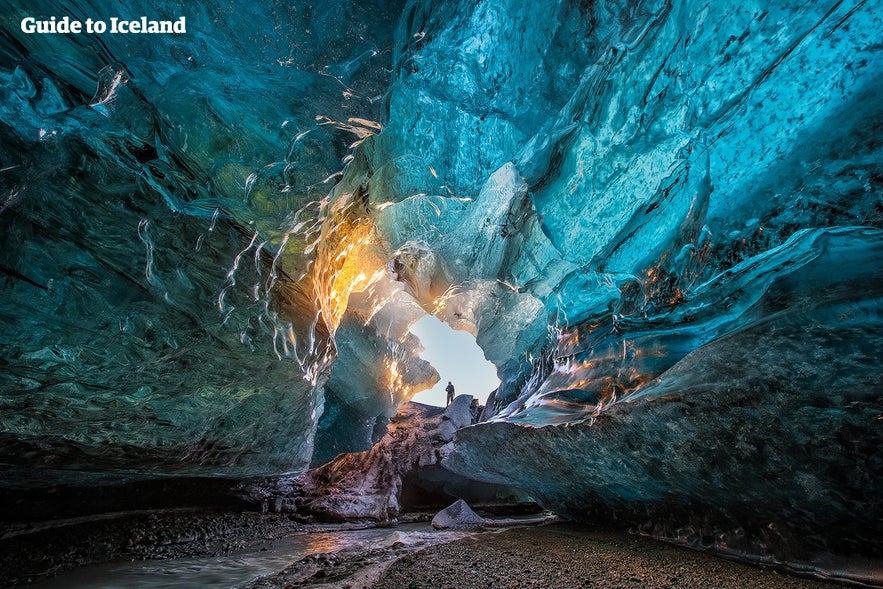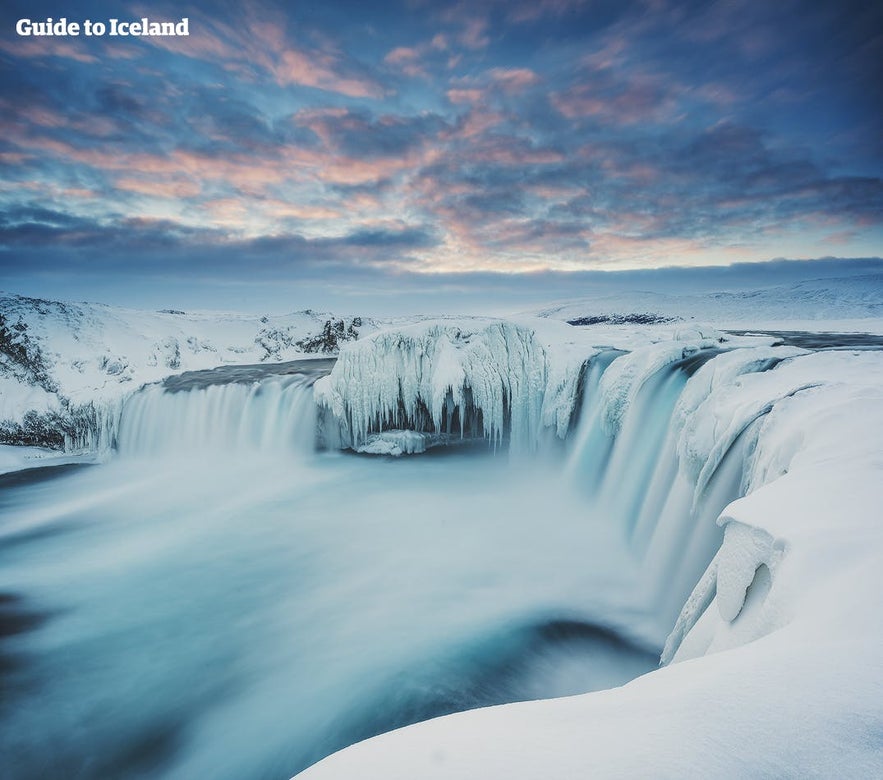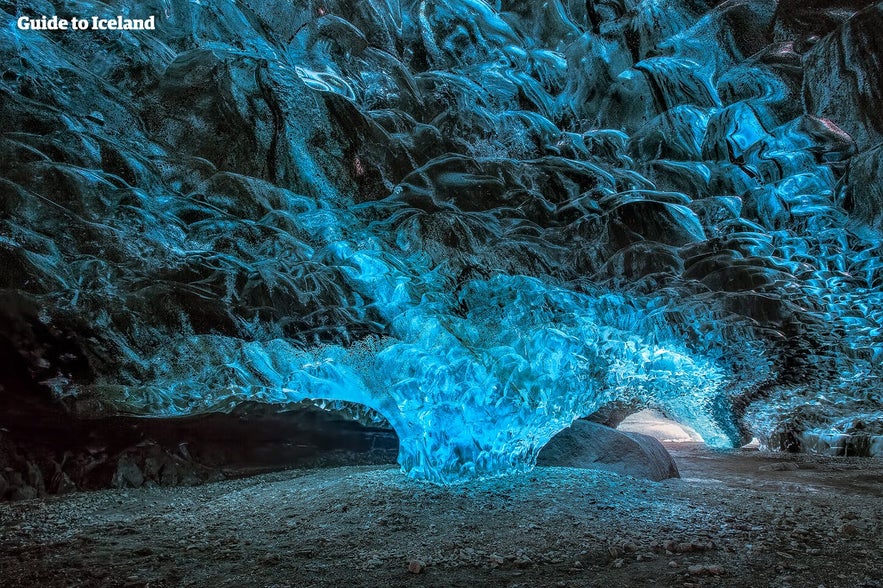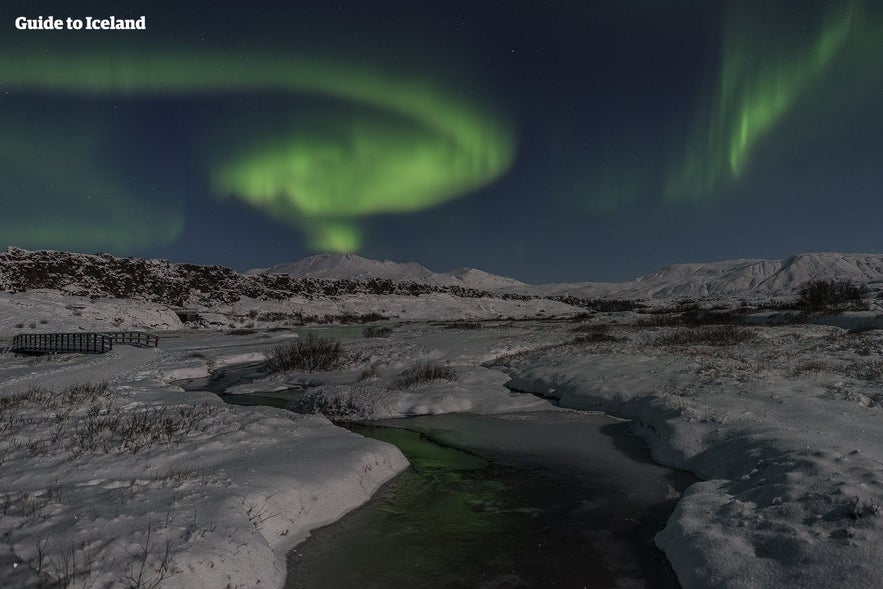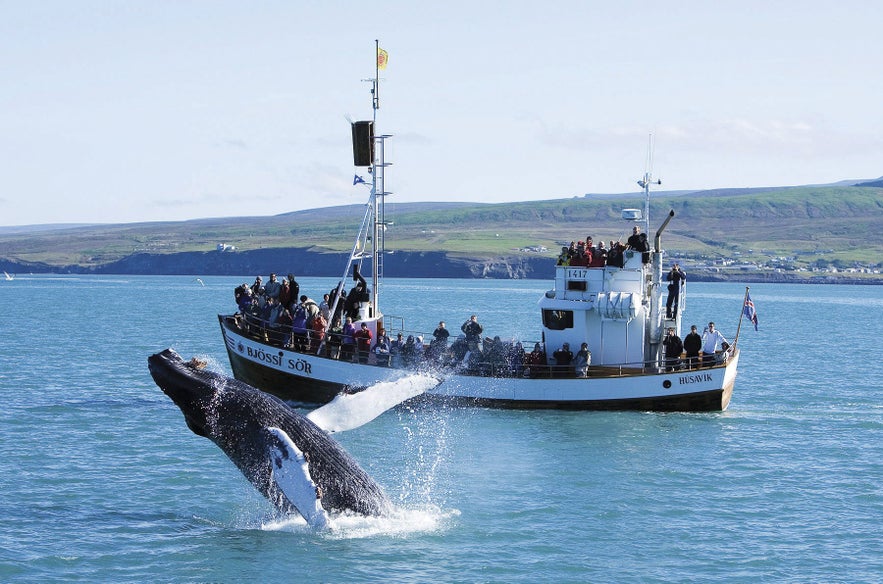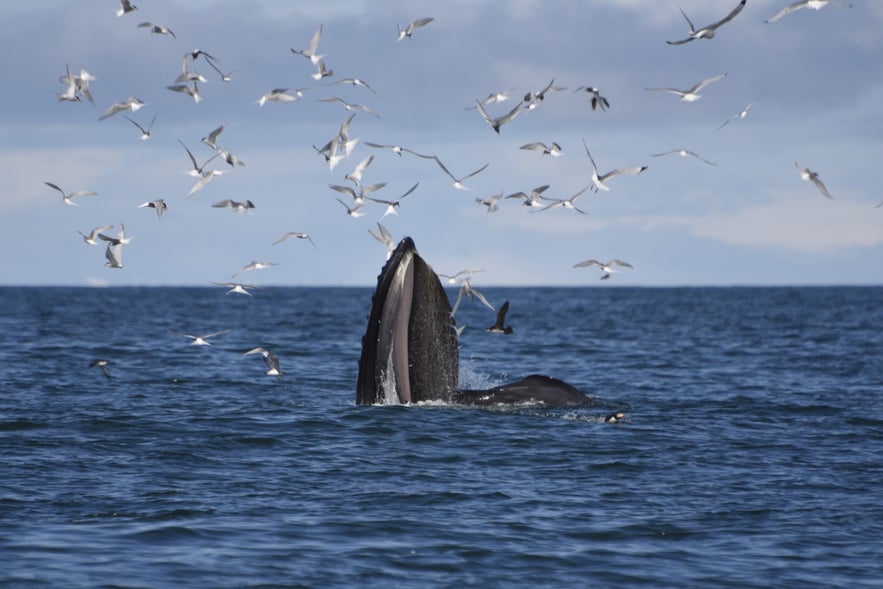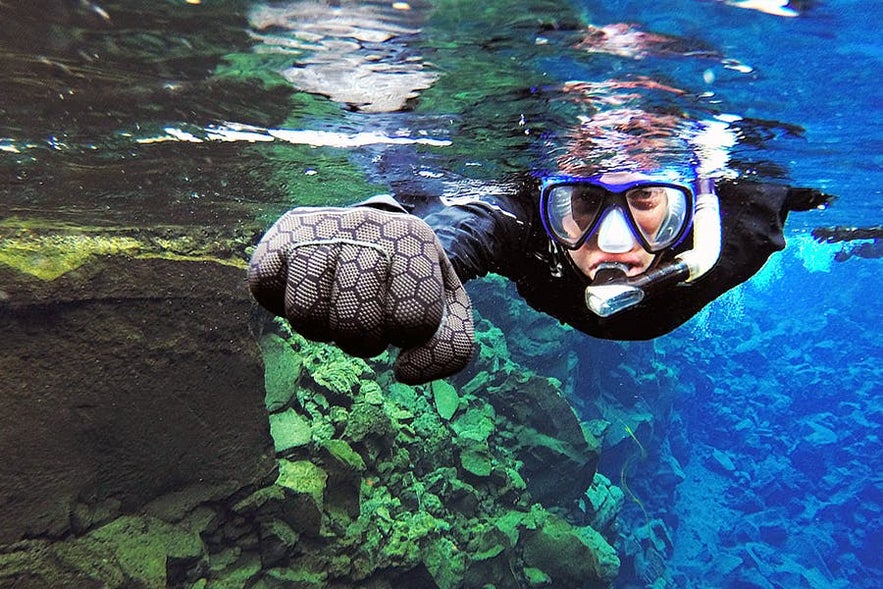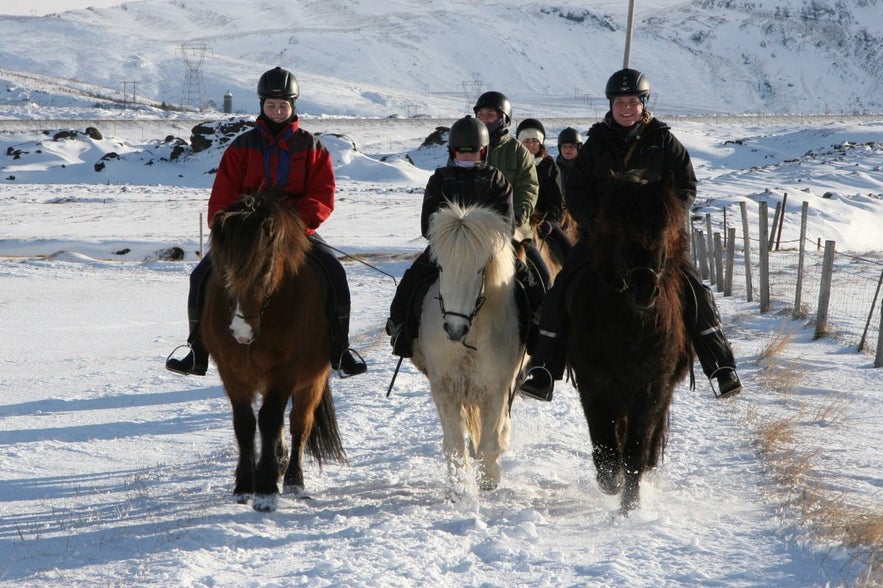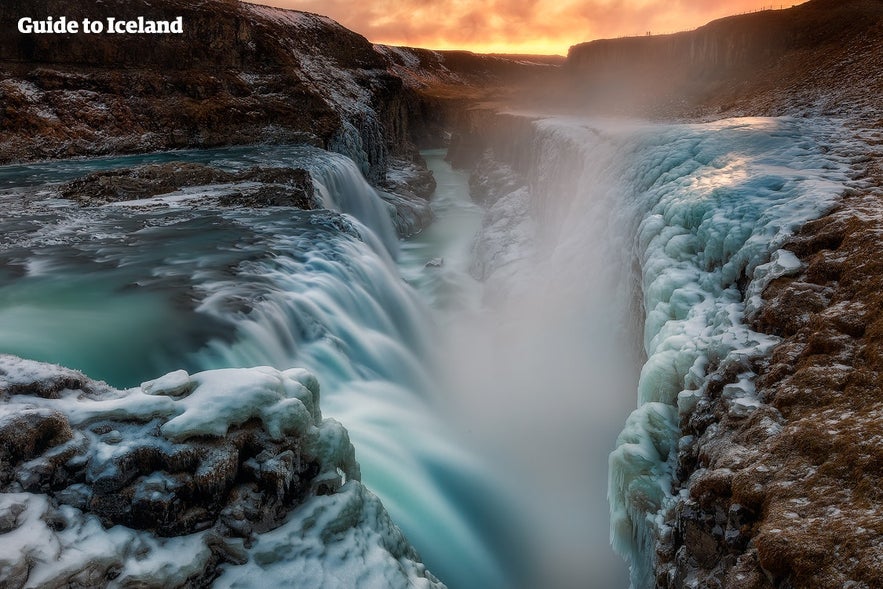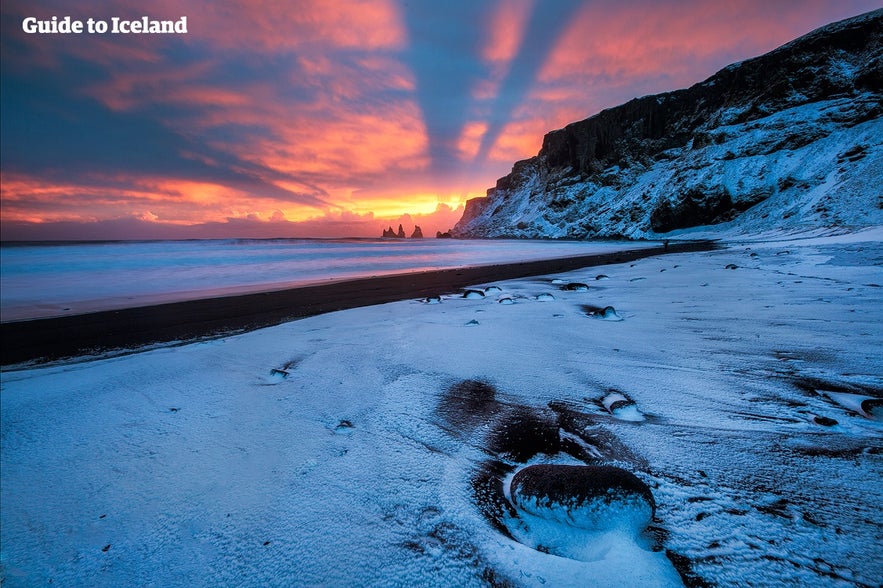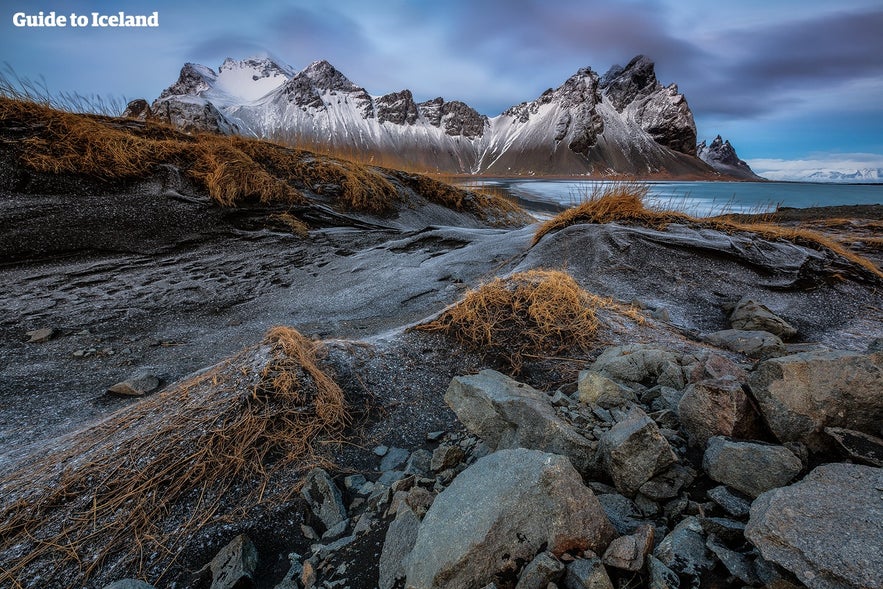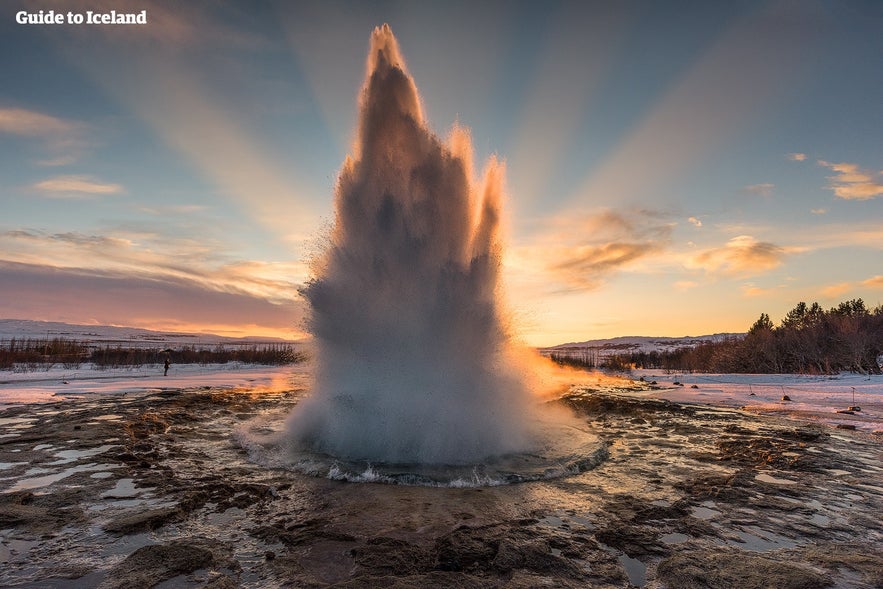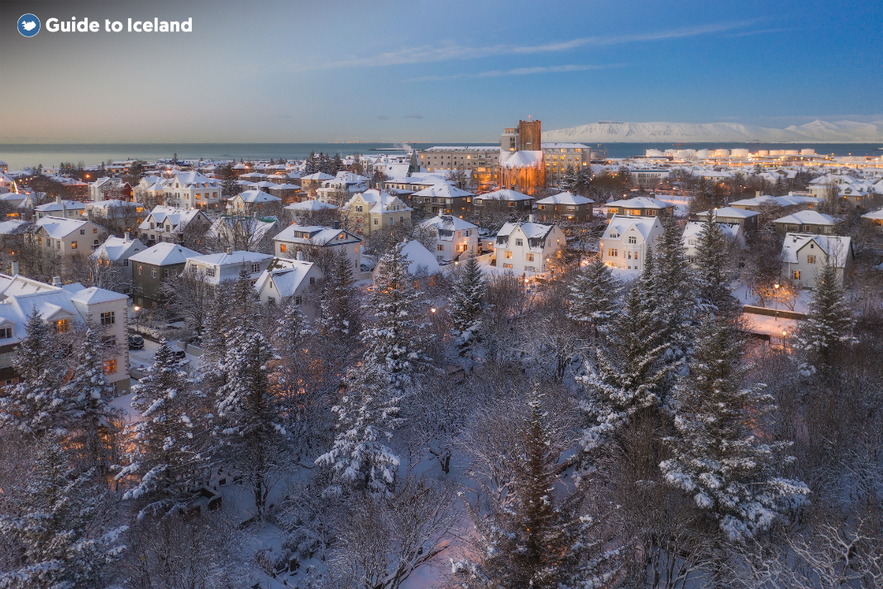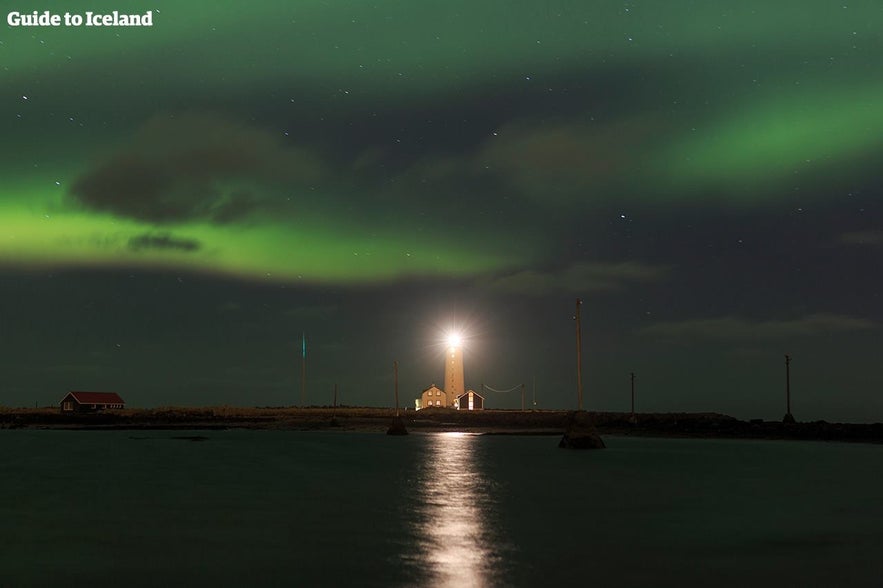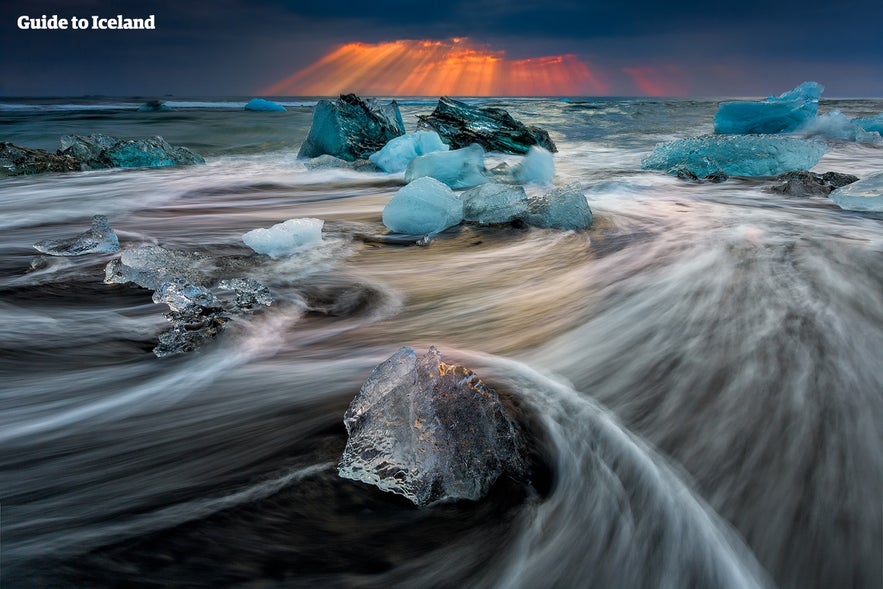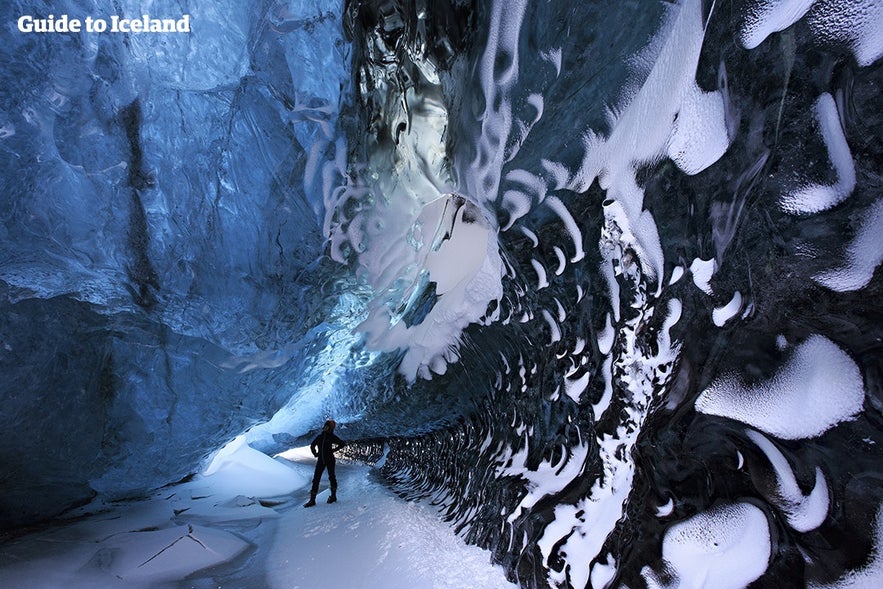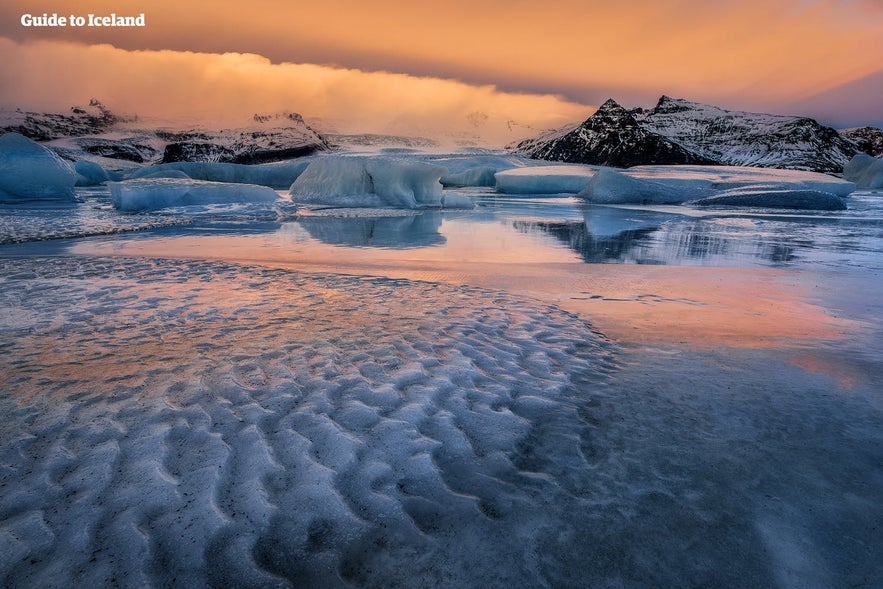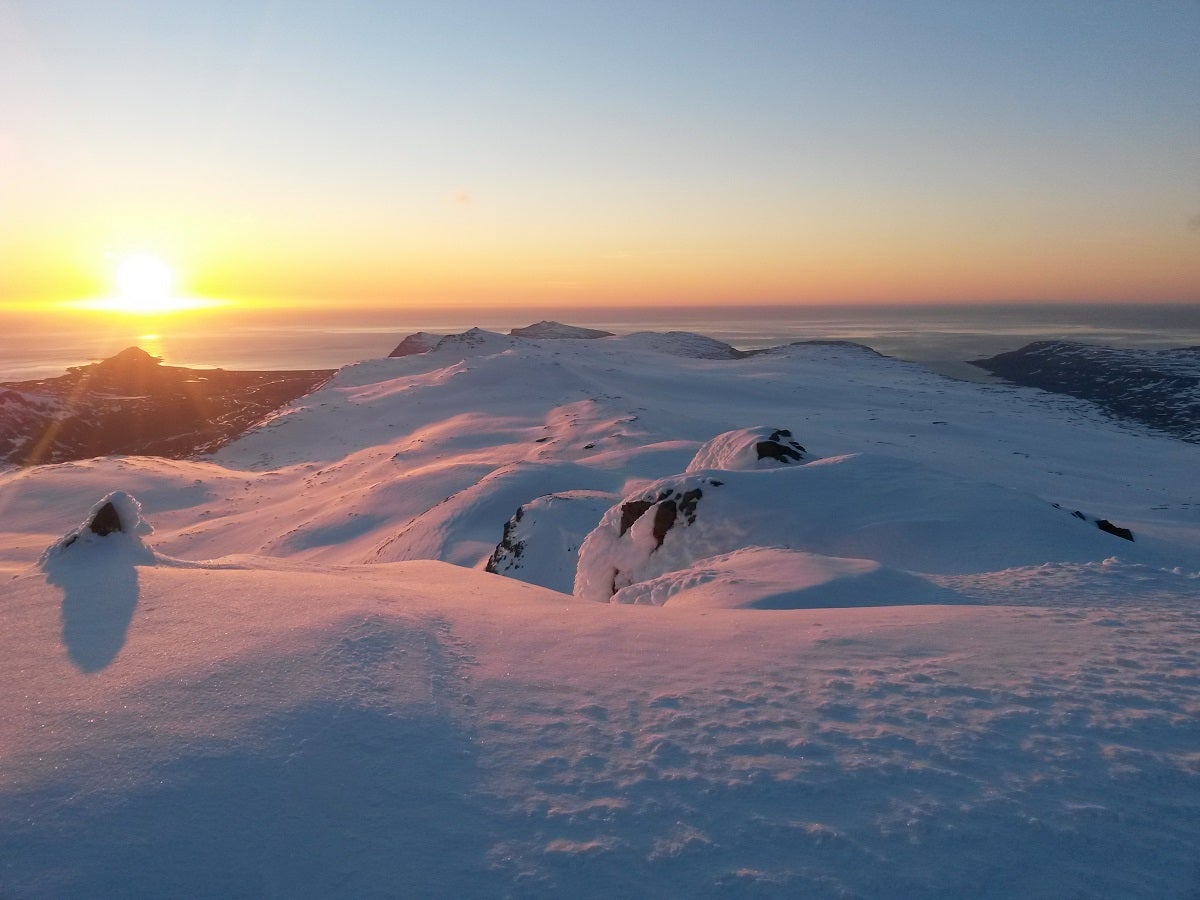Find out everything you need to know about visiting Iceland in March. Learn more about what to do in Iceland in March, from ice caving to seeing the northern lights. Get expert tips on what to pack and what to expect from the weather.
In March, Iceland is still deep in its winter season, with crisp air, lingering snow, and daylight stretching noticeably longer each week. It’s a great time to experience winter activities, and the off-season pricing means better deals on tours in March, flights, and accommodation before summer demand returns.
Why You Can Trust Our Content
Guide to Iceland is the most trusted travel platform in Iceland, helping millions of visitors each year. All our content is written and reviewed by local experts who are deeply familiar with Iceland. You can count on us for accurate, up-to-date, and trustworthy travel advice.
Traveling to Iceland in March also gives you more flexibility. Major attractions are easier to navigate, road conditions gradually improve as the month goes on, and renting a car becomes a more accessible option for exploring the countryside at your own pace.
If the northern lights are high on your list, March offers a good balance of dark nights and clearer skies. For an even better chance of seeing them, consider staying in northern lights hotels, which are especially well-located for aurora viewing, with minimal light pollution and wide open skies.
Beyond northern lights, you’ll also find several cultural festivals this month, along with late-winter adventures like ice caving and glacier tours still in full swing.
Here are some of the best things to do in Iceland in March to get you started!
- Discover everything about Iceland in Winter
- Read about visiting Iceland in February and visiting Iceland in April
What To Know About March in Iceland
Is March a good time to visit Iceland? Absolutely!
You can still enjoy winter tours and activities like visiting ice caves and chasing the northern lights, but it’s the off-season, making it less crowded. However, there are a few things to keep in mind if you're thinking of visiting Iceland in March.
Driving in Iceland in March
Many travelers who come to Iceland throughout the year choose to rent an affordable car in Iceland. Driving in Iceland in March gives you more freedom, but it also means that you may have to deal with icy roads, dark winter nights, snowdrifts, heavy precipitation, high winds, and other drivers who may have less experience than you.
Therefore, renting a car and driving in Iceland in March is only recommended for confident drivers who are used to driving in cold weather. During the winter months, it's best to rent a four-wheel-drive vehicle.
In March, all vehicles use winter tires, but you can request studded tires for a better grip if you want to be extra careful (until April).
If there's heavy weather, keep an eye out for road markings that might be under the snow, and be careful where you park because towing services are not included in most insurance packages and can be very expensive. Being cautious in sandy or muddy areas is also advised.
When driving in March, you need to be aware not just of the weather but of the road conditions in Iceland, too. Avalanches and floods are not unheard of in March, so you need to be sure there is no risk of them on your travels. Always check the weather and road information before setting out on the road.
- Read more: How to Drive Safely in Iceland
Best Things To Do in Iceland in March
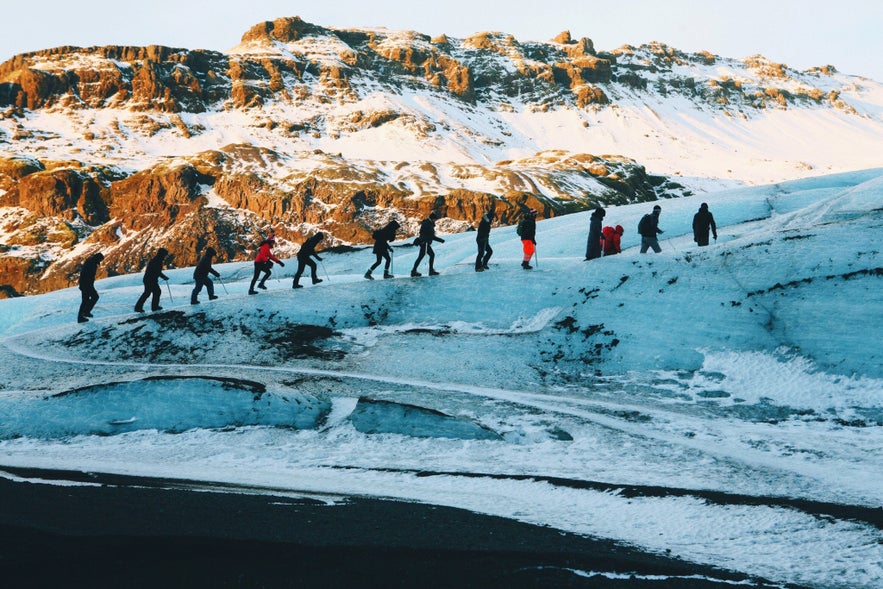
The old Icelandic calendar was very sensibly divided into six winter months and six summer months.
According to this calendar, March is part of winter. Fittingly, many of the top things to do in Iceland, such as ice caving and northern lights hunting, are still running. However, the longer days and slightly increasing temperatures mean that you're not limited to winter activities.
Here are some of the best things to do in Iceland in March.
Visiting the Ice Caves in Iceland in March
 The electric blue ice caves in Vatnajokull Glacier are among Iceland’s most incredible attractions. With just a glance at a few photos or videos, it’s easy to see why they attract visitors from around the world. Most are only open for a few months of the year, and thankfully, March is one of them.
The electric blue ice caves in Vatnajokull Glacier are among Iceland’s most incredible attractions. With just a glance at a few photos or videos, it’s easy to see why they attract visitors from around the world. Most are only open for a few months of the year, and thankfully, March is one of them.
One of the highlights this season is the Crystal Ice Cave, a remarkable natural formation beneath Europe’s largest glacier. Known for its vivid blue ice and striking textures, it offers an unforgettable winter experience.
The ideal way to see this natural wonder is on the best ice cave tour in Iceland. Guided by an experienced professional, you’ll enjoy a safe visit under the best possible conditions.
There are multiple ice cave tours available in Iceland. Some visit ice tunnels, while others are multi-day tours that give you the flexibility to plan your own itinerary while enjoying the winter in Iceland.
You'll need sturdy hiking boots and warm, waterproof clothing. Navigating the glaciers without a trained guide is extremely dangerous, so it’s necessary to join a tour.
This 2-day South Coast and Jokulsarlon Glacier Lagoon tour is available throughout March and takes you ice caving and northern lights hunting.
Spotting the Northern Lights in Iceland in March
Seeing the northern lights is at the top of the list for many people traveling to Iceland. Thankfully, it's still possible to see them in March.
Whenever the sky is dark and clear, and there's enough solar activity, you have a great chance of spotting the aurora borealis dancing in the sky. With the current solar maximum period enhancing auroral activity, your chances are even better than usual.
The best way to find the lights is by taking northern lights tours, as you don't have to worry about driving in challenging conditions. You'll be brought straight to the best spots by experienced guides who know when and where to find the northern lights in Iceland. There are plenty of options if you're coming from Reykjavik.
You could join this magical northern lights minibus tour or hop onto this super jeep northern lights tour with a photographer guide for a more personal experience.
For an even more unique experience, you could take a northern lights boat cruise out into Faxafloi Bay, which departs from Reykjavik Harbor.
While staying in Reykjavik is not recommended if you want to see the northern lights because of light pollution, there are a few recommended aurora spots in the capital where you’re more likely to spot them. If you don’t want to go far from the city, you can take a ferry to Videy Island to try and see them.
Another option is to rent a car and search for the aurora yourself using Iceland's northern lights forecast as your guide. You should, of course, only be hunting in the dark hours, so the evening is the best time.
Keep in mind that driving in Iceland requires caution in March because the roads can still have snow and ice. However, it can be a great way to explore the country as long as you are comfortable with winter road conditions.
Whale Watching in Iceland in March
Photo from Scenic 3 Hour Whale Watching Boat Tour in Faxafloi Bay with Transfer from Reykjavik
Whale watching in Iceland is a great activity all year round. Even in the depths of winter, you can often spot pods of white-beaked dolphins and harbor porpoises. However, in March, the great whales begin to return from their breeding grounds.
If you decide to go on whale watching tours in Iceland in March, you have the best chance of seeing humpback whales and minke whales, but you can also spot orca, fin, and blue whales. Beaked, pilot, and sperm whales also sometimes make an appearance.
Photo from Whale Watching Tour with Transfer from Akureyri
Many tours set off from Reykjavik in a standard whale watching boat, as the weather can be too volatile for smaller RIB boat vessels.
You can also go on a whale-watching tour of the Breidafjordur bay departing from Olafsvik Harbor on the north side of the Snaefellsnes Peninsula. This area provides you with the best chance of seeing orcas in Iceland.
For those who've ventured north, you can take a whale-watching tour from Akureyri. This journey also takes you along one of the longest fjords in all of Iceland.
If you want to make the most of your time, you can also choose to combine activities by taking this whale watching and northern lights boat tour.
Snorkeling and Diving in Iceland in March

Photo from 3-Hour Guided Silfra Diving Tour in a Drysuit with Hot Drinks
Yes, you can snorkel and dive in Iceland in March! The best and most popular destination is the Silfra Fissure. This ravine in Thingvellir National Park is also a freshwater spring and has a visibility of over 300 feet (100 meters).
Even though the water is 35.6 F (2 C), snorkeling in Iceland is a truly thrilling activity you shouldn't miss. This activity is growing in popularity among travelers thanks to Iceland's unique underwater sights.
Note that you must meet the following conditions to snorkel in Iceland (though requirements can vary between tour providers):
Drysuit Snorkeling
-
Minimum age: 12
-
Maximum age: 60
-
Minimum height: 4 feet 9 inches (145 centimeters)
-
Minimum weight: 106 pounds (45 kilograms)
-
Experience needed: must be comfortable swimming
Wetsuit Snorkeling
-
Minimum age: 14
-
Maximum age: 60
-
Minimum height: 4 feet 11 inches (150 centimeters)
-
Minimum weight: 110.3 pounds (50 kilograms)
-
Experience needed: must be comfortable swimming
Drysuit Diving
-
Minimum age: 17
-
Maximum age: 60
-
Minimum height: 4 feet 11 inches (150 centimeters)
-
Minimum weight: 106 pounds (45 kilograms)
-
Experience needed: At least 10 logged drysuit dives OR be drysuit diving certified
Snorkeling is usually done in a drysuit for added protection, but the daring may choose to snorkel in a wetsuit. For scuba diving tours, a drysuit is always required. Additionally, you cannot dive or snorkel while pregnant, and you will need a waiver if you:
-
Are over 60
-
Are over 45 and a heavy drinker or pipe smoker
-
Have a history of respiratory, circulatory, or neurological problems
All tours are led by experienced divemasters who will ensure you’re confident with the equipment and temperatures before setting out.
Glacier Tours in Iceland in March

Iceland's glaciers cover 11% of the country's surface, and glacier hiking is among the most popular activities for visitors.
Most glacier hikes from Reykjavik go to Solheimajokull, an outlet glacier of the Myrdalsjokull Glacier on the South Coast. Solheimajokull Glacier is 98 miles (158 kilometers) south of Reykjavik, close to Seljalandsfoss and Skogafoss Waterfalls, and Eyjafjallajokull Volcano.

Photo from Glacier Hiking Tour on Solheimajokull
Among the many glacier tours in Iceland, two fantastic ways to experience the glaciers are the Solheimajokull Glacier hiking tour and the 10-hour super jeep tour to the Eyjafjallajokull Volcano and Glacier, which departs from Reykjavik.
For a more challenging experience, this glacier hiking tour of the Falljokull Glacier departs from the Skaftafell Nature Reserve in Southwest Iceland. It offers a more immersive walk on the ice, with dramatic crevasses and striking ice formations shaped by one of Vatnajokull’s most dynamic outlet glaciers.
Photo from Snowmobile Tour on Langjokull Glacier with Transfer from Gullfoss Waterfall
Snowmobiling in Iceland is another extremely fun and popular activity to do.
Many people choose this snowmobile tour on the Langjokull Glacier, which includes a transfer from the Gullfoss Waterfall. Another popular option is this super jeep and snowmobiling on the Vatnajokull Glacier, the largest glacier in Europe.
Travelers often choose to include snowmobiling with another experience, such as this Golden Circle and snowmobiling tour from Reykjavik.
Lava Caving Tours in Iceland in March
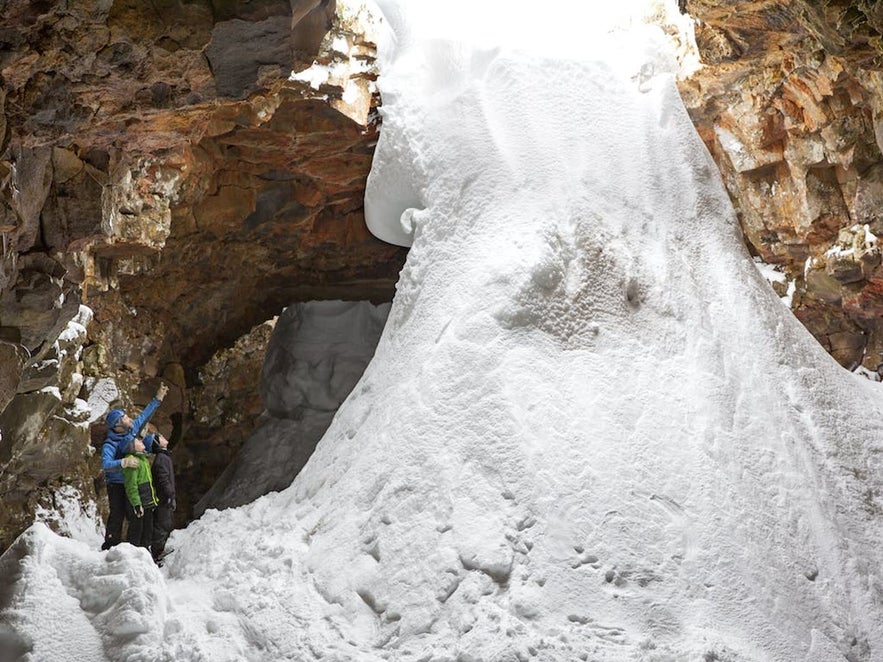
Photo from Classic 1-Hour Raufarholshellir Lava Caving Tour
Lava cave tours are an excellent option when traveling to Iceland in March, as the lava tubes are still decorated with beautiful ice formations that gradually disappear as spring in Iceland approaches. The caves in Iceland are particularly magical during this season, with ice adding an extra layer of beauty to these underground wonders.
Icicles hang from the ceiling, and the ice stalagmites and stalactites give the tunnels an almost fairytale feel. Conditions are stable this time of year, and guides provide all necessary gear.
For an accessible and easy-going trip, you could take the family-friendly Vidgelmir Lava Cave tour or the ever-popular Raufarholshellir Lava Tunnel Cave tour, which has comfortable paths throughout.
Horseback Riding in Iceland in March
Photo from Exceptional 9-Hour Horseback Riding Tour with Geothermal Pool and Transfer from Reykjavik
Horseback riding is a popular activity among Icelanders and travelers alike, regardless of the season. Riding an Icelandic horse is an authentic Icelandic experience, as they're part of the country's history and culture.
Icelandic horses are remarkable creatures. They’re powerful and resilient in the face of challenging weather. But they’re also playful, social, and intelligent, so you're sure to make friends if you meet one. Icelandic horses are famous abroad for their five gaits, including the "tolt," which is unique to them.
What makes the experience memorable is the landscape you ride through. Depending on the location, you might follow quiet countryside trails, pass steaming geothermal fields, or cross frozen rivers with mountain views stretching into the distance. In winter and early spring, the air is crisp, the light is soft, and the scenery feels untouched.
If you'd like to go on horse riding tours in Iceland, there are many options available. You could go for this horseback ride on a black sand beach in Vik or trek with horses to the hot springs in Gufudalur Valley.
If you'd prefer a full-day trip, why not combine horse riding with a Golden Circle tour or take this tour that includes both whale watching and horse riding?
Hot Springs Bathing in Iceland in March
Bathing in geothermal hot water is one of the most relaxing things you can do in Iceland in March. With winter still very much present, there’s nothing quite like sinking into a warm pool while the air around you is crisp and cool. The longer daylight hours mean you can easily plan a soak either during the day or as a peaceful way to end an evening of sightseeing.
Hot springs and geothermal pools in Iceland are open year-round, but March is an especially good time to visit them. The contrast between cold weather and naturally heated water is at its best, and many locations are quieter than during the summer months.
Iconic spots like the Blue Lagoon, with its milky-blue waters surrounded by lava fields, are particularly magical at this time of year, while smaller local pools and natural hot springs offer a more low-key and authentic experience.
Some of the most popular spas operate on timed entry, so it’s worth keeping your travel route and schedule in mind when planning where to bathe.
-
South Iceland: The Secret Lagoon near Fludir is one of the oldest bathing spots in Iceland and has a more natural feel, with steam rising from the surrounding geothermal area. Laugaras Lagoon is a newer addition offering a modern spa experience, while Fontana Geothermal Baths by Lake Laugarvatn are currently under renovation, but they usually fit well into Golden Circle trips.
-
East Iceland: Vok Baths near Egilsstadir are set on Lake Urridavatn and feature floating geothermal pools, with the option to cool off between soaks if you want to experience the hot and cold contrast.
-
North Iceland: Forest Lagoon near Akureyri combines warm water with sweeping views over Eyjafjordur. The Earth Lagoon Myvatn, also known as the Myvatn Nature Baths, is surrounded by lava fields and geothermal landscapes, while GeoSea in Husavik uses naturally heated seawater in infinity pools overlooking the Arctic Ocean.
-
West Iceland: Hvammsvik Hot Springs are set along the coastline and offer multiple pools with varying temperatures, as well as optional cold dipping. Krauma Baths focus on comfort, blending hot water from Deildartunguhver with cold glacier water to create ideal bathing conditions.
-
Reykjavik: Sky Lagoon is a convenient option if you’re staying in the capital and want an easy yet scenic geothermal experience, complete with ocean views and a signature bathing ritual.
In addition to geothermal spas, there are a few natural hot springs in Iceland that you can visit in March. These are simple bathing spots in nature, with no facilities, and conditions depend on the weather.
Reykjadalur, a warm river near Hveragerdi, is one of the easiest natural hot springs to reach and is often accessible year-round. Hellulaug in the Westfjords is another option if you’re traveling in that area, offering a small coastal pool with naturally warm water and ocean views.
It’s generally a good idea to book geothermal spa admission tickets in advance, especially for popular locations like the Blue Lagoon and other well-known hot springs and geothermal pools in Iceland.
For a more affordable alternative, you can also visit the best swimming pools in Iceland, which are geothermally heated and well frequented by locals. These pools offer a relaxed, authentic experience and are an excellent way to enjoy Iceland’s geothermal culture without the higher cost.
Sightseeing in Iceland in March
Iceland offers a wealth of incredible things to see in March. Every region except the Highlands should be at least partially accessible. Be aware that the weather can be unpredictable, though. There can occasionally be flooding, heavy snowfall, or unexpected avalanches.
Nonetheless, March is still a rewarding time to explore Iceland, with quieter roads, dramatic winter-to-spring landscapes, and plenty of activities that remain fully open.
Here’s what to see in Iceland in March.
Driving the Ring Road in Iceland in March
The Icelandic Ring Road, or Route 1, circles the entire country and can usually be completed during March, as long as you have some flexibility in your itinerary in case of bad weather.
Going counterclockwise on this route takes you along the South Coast, through the Eastfjords, across North Iceland, and down the west (without turning into the Westfjords or the Snaefellsnes Peninsula).
The roads in Iceland are generally well-maintained, but ice and heavy snowfall could affect your journey. Winter self-drive tours are mostly recommended for those with experience driving in icy winter conditions.
The South Coast of Iceland is one of its most popular regions. It hosts many of the most famous sites that are accessible from Route 1.
You can see waterfalls like Seljalandsfoss and Skogafoss, glaciers such as Eyjafjallajokull and Solheimajokull, and coastal features such as the Dyrholaey Rock Arch and the Reynisdrangar Sea Stacks.
These sights should be accessible in March, though it may not be possible to take a walk behind Seljalandsfoss Waterfall due to icy conditions.
You should also be careful of admiring the Reynisdrangar Sea Stacks from the Reynisfjara Black Sand Beach. Sneaker waves along the shore can be very dangerous and even fatal, so please stay at least 100 feet (30 meters) from the shoreline at all times. There is a warning light system in place that helps you see which areas of the beach are safe at any time.
The South Coast section of the Ring Road ends at the Jokulsarlon Glacier Lagoon, which is as majestic in March as it is the rest of the year, though some travelers extend the trip to the town of Hofn.
From here, the Ring Road continues through the Eastfjords, a quieter region known for scenic coastal roads and small fishing villages.
When you reach the north of the country, the Ring Road will take you to the Lake Myvatn region. The landscapes here will mesmerize any visitor, but Game of Thrones fans especially are in for a treat. Many of the Game of Thrones filming locations in Iceland are in this region. For instance, the Myvatn area represents the "North of the Wall," where Mance Rayder’s troops camp.
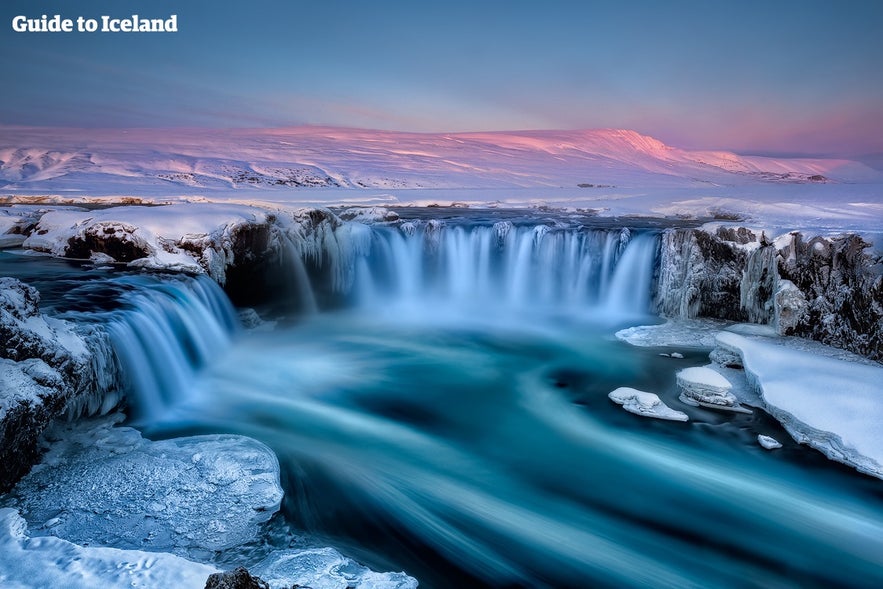
- Learn about the Top Things To See From Akureyri to Snaefellsnes
Visiting the Golden Circle in Iceland in March
Iceland’s most popular sightseeing trail is the Golden Circle. It's definitely worth including in any visit to Iceland.
It's easy to follow the route all year round, even throughout March. The trail will bring you to three of Iceland’s most famous sites: Thingvellir National Park, Geysir Geothermal Area, and Gullfoss Waterfall.
The Thingvellir National Park is a UNESCO World Heritage Site. It was the founding site of the Althingi in the year 930, which is the world’s oldest parliamentary assembly.
The national park is located in both North America and Europe, in a geological sense, as it sits between the North American and Eurasian tectonic plates. This is what gives it such incredible geology, like the Silfra Ravine.
 The Geysir Geothermal Area has its own claim to fame. The English word "geyser" comes from the Icelandic "Geysir," the name of Iceland's most famous hot spring geyser.
The Geysir Geothermal Area has its own claim to fame. The English word "geyser" comes from the Icelandic "Geysir," the name of Iceland's most famous hot spring geyser.
Though Geysir is no longer active, its sister, Strokkur Geyser, erupts every five to ten minutes and can blast water higher than 66 feet (20 meters). The surrounding area is also filled with hot springs, steam vents, and mud pots.
The final site on the Golden Circle trail is Gullfoss, one of the top waterfalls to see in Iceland in winter. The waterfall is even more magical when the rocks around it are covered with glimmering ice, and the surrounding area is buried deep in snow. So, March isn't a bad time to visit.
As well as the main sights, there are plenty of worthwhile detours along the Golden Circle with more natural beauty to discover. This Golden Circle guide can help you map out your route and learn more about the places worth stopping for.
Tour the Snaefellsnes Peninsula in Iceland in March
The Snaefellsnes Peninsula is accessible year-round and continues to attract many visitors. Due to the diversity of its landscapes, this area is often nicknamed "Iceland in Miniature."
Though the mountain passes are likely to be closed (and really should be avoided in March even if open), you can still drive along both sides of the peninsula. This still leaves plenty of accessible highlights around the coast, many of which are among the top things to do on the Snaefellsnes Peninsula.
The route will introduce you to places like Ytri Tunga Beach, which is famous for its seals. There are also the Londrangar Basalt Cliffs, Snaefellsjokull Glacier and Volcano, the fishing villages of Arnarstapi and Hellnar, and the Kirkjufell Mountain, to name a few.
If you get charmed by this beautiful peninsula, you can book accommodation in Snaefellsnes and make the most of your time there.
The Eastfjords in Iceland in March

While the warmer months offer the best overall conditions, you may still be able to visit some of the best places in East Iceland in March, depending on the weather. If conditions are good, the Eastfjords can be especially beautiful at this time of year, and this guide to the Eastfjords can help you map out a route.
While snow will block some of the roads, particularly the mountain passes, you should still be able to navigate the Ring Road and some of the coastal routes.
You can visit the town of Egilsstadir, the largest town in the region, which is close to many attractions, such as the Hallormsstadarskogur Forest and the mystical Lagarfljot Lake. You may be able to access some of the charming coastal villages, but this will depend on the weather and road conditions.
As mentioned earlier, a four-wheel-drive vehicle is essential if you plan to drive through the Eastfjords yourself in March.
Festivals and Traditions in Iceland in March
Reykjavik in March is a busy time, with many of the festivals in Iceland in March taking place in the capital. Some of these festivals are among the top things to do in Reykjavik in March. Easter activities also sometimes cross over into March, giving many locals several days off to celebrate.
Iceland has plenty of unique traditions that take place over this period. Taking part in "Bun Day," "Explosion Day," or "Ash Day" could add some extra fun to your visit and help you to experience local culture.
Below are the main festivals, celebrations, and traditions you can expect in March 2026.
Beer Day
Beer Day is celebrated every year on March 1 and marks the anniversary of Iceland ending its 74-year ban on full-strength beer in 1989. The day has become a light-hearted tradition in Reykjavik, with many bars and breweries offering tastings, happy-hour deals, and special events.
It’s a fun occasion to join if you’re in the capital at the start of the month, and a good excuse to explore Iceland’s growing craft beer scene.
Food & Fun Festival
The Food & Fun Festival is one of Reykjavik’s major culinary events. It brings together guest chefs from around the world and pairs them with local restaurants to create special menus using Icelandic ingredients.
In 2026, the festival runs from late February until March 1, so visitors in early March can still enjoy the final day of the celebrations. Even catching the closing night offers a taste of the creativity and international influence shaping Iceland’s food culture today.
Battle of the Bands Festival

The competition has produced many success stories over the years. Perhaps most notably, the band "Of Monsters and Men" took part in 2010 and went on to achieve international fame in less than a decade. Watching the early rounds in March gives you the chance to see emerging Icelandic talent before they take their next steps in the country’s vibrant music scene.
Mustache March
 November is nicknamed "Movember" or "No-Shave November" in many other countries. It has become traditional for men to grow out their mustaches during this month to raise awareness about men's health issues.
November is nicknamed "Movember" or "No-Shave November" in many other countries. It has become traditional for men to grow out their mustaches during this month to raise awareness about men's health issues.
But Icelanders prefer to grow out their facial hair in March and seek to raise awareness and funds for a broad cross-section of cancer research. They call the occasion "Mustache March" or 'Mottumars' in Icelandic. Even the city buses have mustaches stuck on their fronts!
The initiative is usually advertised with some very quirky advertisements, one of which you can see in the video above, and locals can even compete in a beard competition as a form of fundraising.
If you're coming to Iceland in March, consider growing your mustache to fit in with the beardy crowd! You can also buy special socks to support the initiative, which can be found in grocery stores and other shops around Iceland during this time.
Weather in Iceland in March
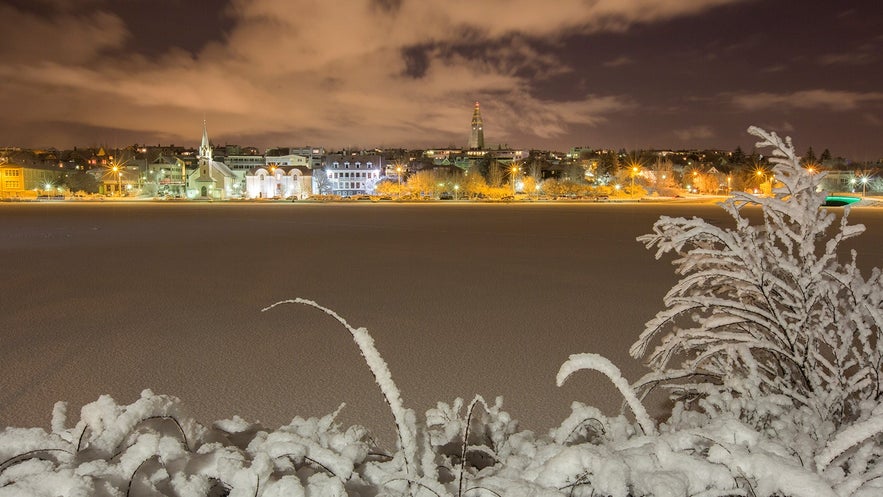 How cold is Iceland in March? It is still winter, but a noticeably softer version of it. March in Iceland brings a mix of snow, sleet, rain, and windy days, especially along the South Coast and around Reykjavik.
How cold is Iceland in March? It is still winter, but a noticeably softer version of it. March in Iceland brings a mix of snow, sleet, rain, and windy days, especially along the South Coast and around Reykjavik.
The weather in Reykjavik in March is slightly milder than in other regions, but conditions can still shift quickly between rain, snow, and strong winds. Precipitation in the capital averages around 80 to 90 mm, and the southern region often sees more.
The north and the Westfjords stay colder with more frequent snowfall, while the east tends to be drier. Even with winter conditions, longer days and improving light make traveling in Iceland in March more comfortable than earlier in the season, and the landscapes still look freshly coated and dramatic.
For current forecasts and weather alerts in Iceland, check the Icelandic Meteorological Office.
Average Temperatures in Iceland in March
Average temperatures in Iceland in March vary depending on the region. In Southwest Iceland, including Reykjavik and the Reykjanes Peninsula, March usually ranges from 28 F to 39 F (-2 C to 4 C).
South Iceland, which includes the Golden Circle, Selfoss, and Vik, is slightly warmer in March at 30 F to 41 F (-1 C to 5 C), and tends to get more rain than snow at lower elevations.
West Iceland and the Snaefellsnes Peninsula sit between 28 F and 37 F (-2 C to 3 C), while the Westfjords are noticeably colder in March at 25 F to 36 F (minus 4 C to 2 C).
North Iceland, including Akureyri, Husavik, and the Lake Myvatn area, also stays on the colder side in March, ranging from 25 F to 37 F (-4 C to 3 C) with frequent snow.
East Iceland, especially around Egilsstadir, generally falls between 27 F and 37 F (-3 C to 3 C) and stays relatively dry in March compared to other regions.
The Highlands remain fully winterbound throughout March, with temperatures often between 14 F and -4 F (-10 C to -20 C).
Daylight in Iceland in March
One of the biggest perks of visiting Iceland in March is the rapidly increasing daylight. Early in the month, sunrise is around 8:30 AM, and sunset is near 6:45 PM, giving roughly 10 hours of daylight. By mid-March, sunrise shifts to around 7:45 AM and sunset to 7:30 PM, offering close to 11.5 hours.
Late March brings some of the most welcome changes of the season, with sunrise around 6:45 AM and sunset near 8:00 PM, giving more than 13 hours of daylight. These longer days make exploring easier, whether you’re sightseeing, road tripping, or hoping for a clear-night window to catch the northern lights.
- See also: Understanding Time in Iceland
What To Wear in Iceland in March
If you are traveling to Iceland in March, be prepared for cold and potentially wet weather. The weather in Iceland can change quickly, so it might still rain even if the weather seems pleasant in the morning. Knowing what to pack for Iceland makes a big difference, and waterproof outer layers plus warm clothing should be part of anything you take when leaving your accommodation.
The best clothes to wear in Iceland in winter include warm outer layers, complete with thermal underwear and windproof outerwear. A hat and a good pair of gloves are also required for exploring the outdoors in Iceland in March.
Footwear matters too, as icy sidewalks and wet trails are common throughout the month. Waterproof, insulated boots with good traction will make walking far more comfortable and safer. A neck gaiter or scarf is also useful for windy days, especially in open areas or along the coast.
It is also practical to bring a mid-layer fleece or lightweight down jacket for warmth, along with moisture-wicking base layers that help regulate body temperature during changing conditions. For longer outdoor excursions, consider packing crampons or microspikes for improved grip on icy paths.
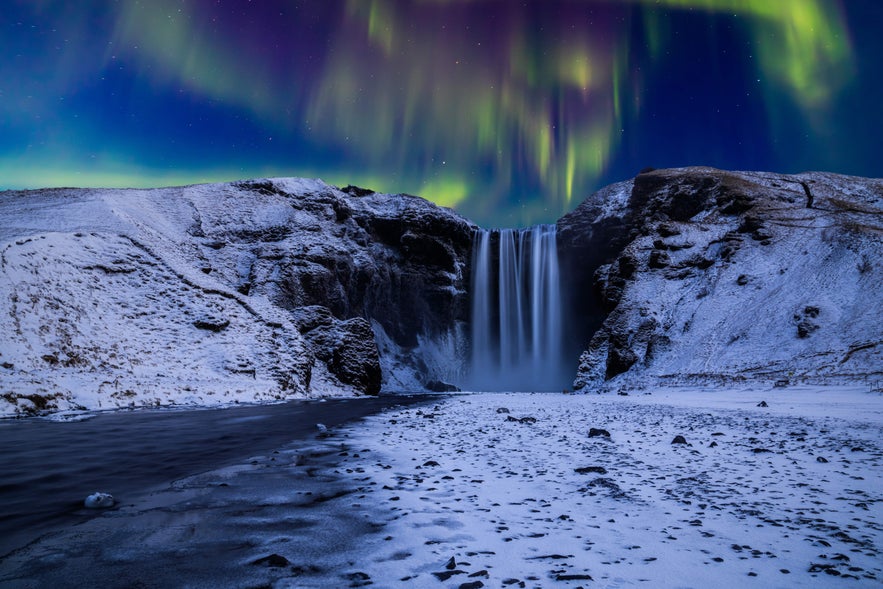 If you plan to visit waterfalls, black sand beaches, or higher viewpoints, expect spray, strong gusts, and colder air, and dress accordingly.
If you plan to visit waterfalls, black sand beaches, or higher viewpoints, expect spray, strong gusts, and colder air, and dress accordingly.
Tech items benefit from protection too. A waterproof phone pouch or dry bag keeps electronics safe during rain or snow showers. Hand warmers can make a noticeable difference during long periods outdoors, especially if you are waiting to photograph the northern lights at night. Sunglasses are surprisingly helpful as well, as snow glare can be strong on sunny days.
You should check the weather forecast each day to plan ahead. Compared to the darker winter months, storms are less common in March, but they can still happen. High winds often accompany them, so be sure to check for weather warnings.
Tour Options for Iceland in March
Many tours in Iceland in March include must-see attractions and authentic experiences such as chasing the northern lights, exploring ice caves, and witnessing spectacular winter landscapes.
There are several ways you can enjoy these activities on your holiday in Iceland. You can book guided winter tour packages, in which all of your accommodation, transfers, and tours are taken care of before arrival. They’re an easy way to structure an Iceland trip in March without having to plan every detail yourself.
Or self-drive winter tours might suit you better. This means you'll navigate the country yourself with a car rental, but have your itinerary and your accommodation pre-organized for you.
If you want to split your time between enjoying the capital and the rest of the country, you can also book accommodations in Reykjavik and take advantage of some of the fantastic day tours from Reykjavik. This is the best option if you prefer to avoid driving in Iceland, but still want to see the fantastic landscapes beyond the capital.
With so many options available to you, it's worth spending some time browsing and researching to find the best tour packages for you.
March in Iceland is truly remarkable. It's an excellent time to visit if you seek the wintry landscapes, sparse crowds, and longer spring days to fill with activities. As long as you dress appropriately and make responsible choices regarding driving and tours, you're sure to have a great visit to the Land of Ice and Fire!
Recommended Itineraries for March in Iceland
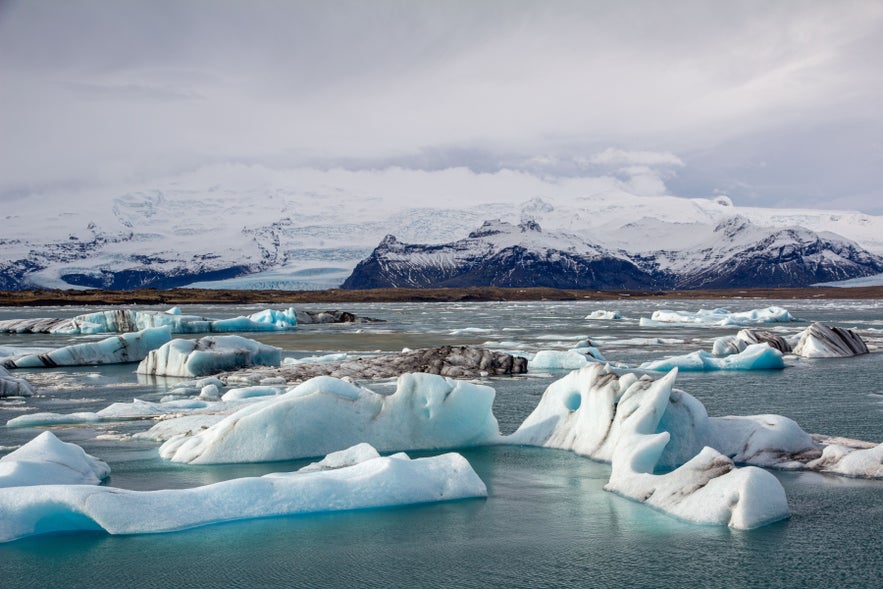 If you are planning to travel to Iceland in March, these itineraries offer dependable options that match the season. Each itinerary includes winter activities such as ice caving, northern lights excursions, and visits to the Golden Circle or the South Coast. All of these experiences are available throughout March.
If you are planning to travel to Iceland in March, these itineraries offer dependable options that match the season. Each itinerary includes winter activities such as ice caving, northern lights excursions, and visits to the Golden Circle or the South Coast. All of these experiences are available throughout March.
-
8-Day Guided Ring Road Tour with Top Activities: This full-circle guided journey takes you around the entire Ring Road. It includes major regions of Iceland and classic winter experiences such as ice caving, glacier visits, and northern lights hunting. It is ideal for travelers who prefer a structured guided itinerary.
-
7-Day Northern Lights Self-Drive Tour: This self-drive route covers the Golden Circle, the South Coast, and the Snaefellsnes Peninsula. It also includes a guided blue ice cave tour. The itinerary provides flexibility while still covering Iceland’s main winter highlights.
-
6-Day Northern Lights Adventure Package with Ice Caving: This guided itinerary includes the Golden Circle, the South Coast, a natural blue ice cave in Vatnajokull, and a visit to the Blue Lagoon. It is a very good option if you prefer not to drive in March conditions.
-
5-Day Winter Vacation Package with Ice Caving and the Blue Lagoon: A shorter itinerary that still includes essential winter experiences. It features a blue ice cave tour, the most famous sights along the South Coast, and a visit to the Blue Lagoon. It also offers several opportunities to look for the northern lights.
-
3-Day Northern Lights and Ice Cave Tour: A fast-paced option that covers the Golden Circle, the South Coast, Jokulsarlon Glacier Lagoon, and the Crystal Ice Cave. Evening northern lights excursions are also included, giving you a full winter experience in a short timeframe.
FAQs About Iceland in March
What is Iceland like in March?
Iceland in March still feels like winter, but the month has two different moods. Iceland in early March is closer to deep winter: snow-covered landscapes, crisp air, and slower, darker mornings. It feels quiet and remote, with fewer people around and a strong “out in the elements” vibe when you’re walking city streets or standing by a frozen waterfall.
As the month goes on, Iceland in late March feels noticeably lighter and a bit softer. Daylight stretches well into the evening, the snow starts to retreat in places, and you get more breaks of blue sky between showers of snow or rain. Roads and sightseeing become a little easier, but the scenery is still very much wintery.
What is the weather like in Iceland in March?
Iceland in March is still winter, with temperatures in Southwest Iceland, including Reykjavik, typically ranging from 28 F to 39 F (-2 C to 4 C). The north, east, and Westfjords are colder, averaging around 25 F to 37 F (-4 C to 3 C).
Weather conditions shift quickly and can bring rain, sleet, snow, or strong winds throughout the day. Reykjavik receives about 80 to 90 mm of precipitation in March, with higher amounts along the South Coast.
Is there snow in Iceland in March?
Yes, March is still very much a winter month in Iceland, and snow is common across the country. You’ll see the most snow in North Iceland and the Westfjords, where winter conditions often last into April. The South Coast and Reykjavik get a mix of snow, sleet, and rain, but fresh snowfalls can still happen throughout the month.
Can I drive around Iceland in March?
Yes, visitors can still drive around Iceland in March but should be aware that the weather can be unpredictable and some roads may be closed due to snow or ice. Visitors should check road conditions before setting out on a journey and consider renting a four-wheel drive vehicle.
Are the roads open in Iceland in March?
Most major roads in Iceland remain open in March, including the Ring Road and popular routes like the Golden Circle and the South Coast. However, winter conditions can still cause temporary closures, especially during storms. Rural roads, mountain passes, and all Highland F-roads stay closed or are often impassable due to snow, ice, and poor visibility.
If you’re driving, always check the weather forecast and road updates from umferdin.is/road.is before heading out. A four-wheel-drive vehicle is highly recommended in March, as you may encounter icy stretches, drifting snow, and strong winds. Flexibility in your itinerary is essential as conditions can change quickly, and delays are common.
What are the daylight hours in Iceland in March?
In March, Iceland experiences rapidly increasing daylight, offering far more time for sightseeing and outdoor activities. Early in the month, sunrise is around 8:30 AM, and sunset is about 6:45 PM. By mid-March, daylight stretches to roughly 11.5 hours, and by late March, Iceland enjoys more than 13 hours of daylight, with sunrise around 6:45 AM and sunset near 8:00 PM.
What are the popular attractions to visit in Iceland in March?
Popular attractions in Iceland in March include the Golden Circle, where you can visit Thingvellir National Park, the Geysir Geothermal Area, and Gullfoss Waterfall. Along the South Coast, Seljalandsfoss Waterfall, Skogafoss Waterfall, Reynisfjara Black Sand Beach, and the glaciers near Vik are top stops.
The natural ice caves in Vatnajokull are among the most sought-after winter attractions in March, and geothermal spas like the Blue Lagoon and Sky Lagoon remain popular year-round. Visiting the Blue Lagoon in March is especially appealing, as the contrast between the warm mineral water and the crisp winter air makes the experience even more memorable.
Clear nights also make the northern lights one of the most memorable attractions to see during this month.
What are the popular winter sports and activities in Iceland in March?
March is a great time for winter sports and activities in Iceland, including skiing and snowboarding, snowmobiling, glacier hiking, and ice climbing. Ski resorts such as Blafjoll near Reykjavik and Hlidarfjall in Akureyri usually offer good conditions, while guided winter adventures on glaciers and snowfields remain popular thanks to longer daylight hours and stable snow.
What are some unique experiences to have in Iceland in March?
In March, visitors can enjoy unique experiences such as dog sledding, ice fishing, and visiting an ice cave. Visitors can also enjoy the beauty of the winter landscape and the opportunity to see the northern lights.
Can I see whales in Iceland in March?
Yes, you can see whales in Iceland in March, and it’s a good month for early-season whale watching. Several species remain close to Icelandic shores throughout winter, including white-beaked dolphins and harbour porpoises, which are commonly seen on tours from Reykjavik and North Iceland.
Whale watching in Iceland is possible year-round, but March is when sightings of larger whales begin to increase. Humpback whales start returning from their winter migrations at this time, making them more common around areas like Husavik and Akureyri.
While you won’t see the large summer feeding groups or peak blue whale activity yet, March still offers reliable whale watching conditions, and year-round tours operate from the major ports.
Can I see puffins in Iceland in March?
Puffins do not return to Iceland until April or May, so they are not typically seen in March. However, visitors may still be able to see other bird species, such as the snow bunting. If you’re planning a later visit, it’s worth looking into where to see puffins in Iceland once the breeding season begins.
Is it possible to see the northern lights in Iceland in March?
Yes, it is possible to see the northern lights in Iceland in March, as the winter months offer the best chances for viewing. In fact, March still falls within the best time to see the northern lights in Iceland, thanks to dark nights and active aurora conditions. However, visitors should be aware that the northern lights are a natural phenomenon and can never be guaranteed.
Are there any cultural events or festivals in Iceland in March?
The Reykjavik Food and Fun Festival takes place in March and features world-renowned chefs cooking at the many high-quality restaurants in Reykjavik. Other events include Battle of the Bands, Easter celebrations, and St. Patrick's Day festivities in Reykjavik.
What should I pack for a trip to Iceland in March?
Visitors should pack warm, waterproof, and windproof clothing, including a heavy coat, thermal layers, gloves, and a hat. Sturdy waterproof boots with good traction are also recommended. Other useful items to pack include a camera, binoculars, and a portable phone charger.
Is March a good time to visit Iceland for budget travelers?
March can be a good time to visit Iceland for budget travelers, as it is considered the off-season and some hotels and tours may offer lower rates. However, visitors should still expect to pay higher prices than in many other countries.
Are there any restrictions or closures in Iceland during March?
Mostly not, but tourist attractions, such as museums and restaurants, may have limited hours or be closed in March, especially in more remote areas. Visitors should check the opening times and availability of attractions and services in advance.
What should I be aware of when traveling to Iceland in March?
Visitors should be aware of the weather conditions and dress appropriately. Roads may be icy or snowy, and daylight hours can be limited. It is also important to be aware of the dangers of avalanches and to check for travel warnings and updates.
Have we answered your questions on what Iceland is like in March? Did you find out what to do in Iceland? Did any of the festivals and events in Reykjavik in March catch your eye? Let us know which tour or event you’re most intrigued by in the comments.

